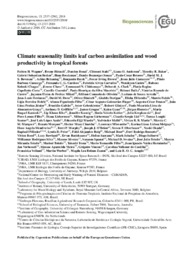Climate seasonality limits leaf carbon assimilation and wood productivity in tropical forests.
Climate seasonality limits leaf carbon assimilation and wood productivity in tropical forests.
Author(s): WAGNER, F. H.; HÉRAULT, B.; BONAL, D.; STAHL, C.; ANDERSON, L. O.; BAKER, T. R.; BECKER, G. S.; BEECKMAN, H.; SOUZA, D. B.; BOTOSSO, P. C.; BOWMAN, D. M. J. S.; BRÄUNING, A.; BREDE, B.; BROWN, F. I.; CAMARERO, J. J.; CAMARGO, P. B.; CARDOSO, F. C. G.; CARVALHO, F. A.; CASTRO, W.; CHAGAS, R. K.; CHAVE, J.; CHIDUMAYO, E. N.; CLARK, D. A.; COSTA, F. R. C.; COURALET, C.; MAURICIO, P. H. da S.; DALITZ, H.; CASTRO, V. R. de; MILANI, J. E. de F.; OLIVEIRA, E. C. de; ARRUDA, L. de S.; DEVINEAU, JEAN-LOUIS; DREW, D. M.; DÜNISCH, O.; DURIGAN, G.; ELIFURAHA, E.; FEDELE, F.; FEDELE, L. F.; FIGUEIREDO FILHO, A.; FINGER, C. A. G.; FRANCO, A. C.; FREITAS JÚNIOR, J. L.; GALVÃO, F.; GEBREKIRSTOS, A.; GLINIARS, R.; GRAÇA, P. M. L. de A.; GRIFFITHS, A. D.; GROGAN, J.; GUAN, K.; HOMEIER, J.; KANIESKI, M. R.; KHO, L. K.; KOENIG, J.; KREPKOWSKI, J.; LEMOS-FILHO, J. P.; LIEBERMAN, D.; LIEBERMAN, M. E.; LISI, C. S.; SANTOS, T. L.; LÓPEZ AYALA, J. L.; MAEDA, E. E.; MALHI, Y.; MARIA, V. R. B.; MARQUES, M. C. M.; MARQUES, R.; CHAMBA, H. M.; MBWAMBO, L.; MELGAÇO, K. L. L.; MENDIVELSO, H. A.; MURPHY, B. P.; O’BRIEN, J. J.; OBERBAUER, S. F.; OKADA, N.; PÉLISSIER, R.; PRIOR, L. D.; ROIG, F. A.; ROSS, M.; ROSSATTO, D. R.; ROSSI, V.; ROWLAND, L.; RUTISHAUSER, E.; SANTANA, H.; SCHULZE, M.; SELHORST, D.; SILVA, W. R.; SILVEIRA, M.; SPANNL, S.; SWAINE, M. D.; TOLEDO, J. J.; TOLEDO, M. M.; TOLEDO, M.; TOMA. T.; TOMAZELLO FILHO, M.; VALDEZ HERNÁNDEZ, J. I.; VERBESSELT, J.; VIEIRA, S. A.; VINCENT, G.; CASTILHO, C. V. de; VOLLAND, F.; WORBES, M.; ZANON, M. L. B.; ARAGÃO, L. E. O. C.
Summary: The seasonal climate drivers of the carbon cy- cle in tropical forests remain poorly known, although these forests account for more carbon assimilation and storage than any other terrestrial ecosystem. Based on a unique combina- tion of seasonal pan-tropical data sets from 89 experimental sites (68 include aboveground wood productivity measure- ments and 35 litter productivity measurements), their asso- ciated canopy photosynthetic capacity (enhanced vegetation index, EVI) and climate, we ask how carbon assimilation and aboveground allocation are related to climate seasonal- ity in tropical forests and how they interact in the seasonal carbon cycle. We found that canopy photosynthetic capacity seasonality responds positively to precipitation when rain- fall is < 2000 mm yr-1 (water-limited forests) and to radia- tion otherwise (light-limited forests). On the other hand, in- dependent of climate limitations, wood productivity and lit- terfall are driven by seasonal variation in precipitation and evapotranspiration, respectively. Consequently, light-limited forests present an asynchronism between canopy photosyn- thetic capacity and wood productivity. First-order control by precipitation likely indicates a decrease in tropical forest pro- ductivity in a drier climate in water-limited forest, and in cur- rent light-limited forest with future rainfall < 2000 mm yr-1.
Publication year: 2016
Types of publication: Journal article
Unit: Embrapa Forestry
Keywords: Carbon sinks, Carbono, Climate change, Floresta tropical, Madeira, Mudança Climática, Tropical forests, Wood
Observation
Some of Embrapa's publications are published as ePub files. To read them, use or download one of the following free software options to your computer or mobile device. Android: Google Play Books; IOS: iBooks; Windows and Linux: Calibre.
Access other publications
Access the Agricultural Research Database (BDPA) to consult Embrapa's full library collection and records.
Visit Embrapa Bookstore to purchase books and other publications sold by Embrapa.

